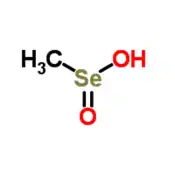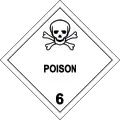Acide méthaneséléninique
L'acide méthaneséléninique (MSA) est un composé chimique de formule CH3SeOOH. Cet oxoacide du sélénium se présente sous la forme d'un solide cristallisé dont la géométrie des molécules a pu être caractérisée par cristallographie aux rayons X : les liaisons Se-C, Se-O et Se-OH ont respectivement pour longueurs 192,5 pm, 167,2 pm et 175,6 pm, tandis que les angles OSeO, HO-Se-C et OSeC mesurent respectivement 103,0°, 93,5° et 101,4°[3].
| Acide méthaneséléninique | |||
 Structure de l'acide méthaneséléninique |
|||
| Identification | |||
|---|---|---|---|
| Nom UICPA | acide méthaneséléninique | ||
| Synonymes |
acide méthanesélénique, |
||
| No CAS | |||
| No ECHA | 100.123.107 | ||
| PubChem | 161597 | ||
| SMILES | |||
| InChI | |||
| Propriétés chimiques | |||
| Formule | CH4O2Se [Isomères] |
||
| Masse molaire[1] | 127 ± 0,03 g/mol C 9,46 %, H 3,17 %, O 25,2 %, Se 62,17 %, |
||
| Propriétés physiques | |||
| T° fusion | 128 à 132 °C[2] | ||
| Précautions | |||
| SGH[2] | |||
    Danger |
|||
| Transport[2] | |||
|
|||
| Unités du SI et CNTP, sauf indication contraire. | |||
L'acide méthaneséléninique fait l'objet de recherches dans le domaine des traitements anticancéreux. Le méthylsélénol CH3SeH peut être produit in vivo par réduction du CH3SeOOH et pourrait être le métabolite clé des effets du sélénium contre certains cancers à travers la génération de superoxydes[4]. La réduction de l'acide méthaneséléninique par la thiorédoxine réductase des mammifères a également été étudiée[5].
Notes et références
- Masse molaire calculée d’après « Atomic weights of the elements 2007 », sur www.chem.qmul.ac.uk.
- Fiche Sigma-Aldrich du composé Methaneseleninic acid 95%, consultée le 14 mai 2013.
- (en) Eric Block, Marc Birringer, Weiqin Jiang, Tsukasa Nakahodo, Henry J. Thompson, Paul J. Toscano, Horst Uzar, Xing Zhang et Zongjian Zhu, « Allium Chemistry: Synthesis, Natural Occurrence, Biological Activity, and Chemistry of Se-Alk(en)ylselenocysteines and Their γ-Glutamyl Derivatives and Oxidation Products », Journal of Agricultural and Food Chemistry, vol. 49, no 1, , p. 458-470 (lire en ligne) DOI 10.1021/jf001097b
- (en) Julian E. Spallholz, Brent J. Shriver et Ted W. Reid, « Dimethyldiselenide and Methylseleninic Acid Generate Superoxide in an In Vitro Chemiluminescence Assay in the Presence of Glutathione: Implications for the Anticarcinogenic Activity of L-Selenomethionine and L-Se-Methylselenocysteine », Nutrition and Cancer, vol. 40, no 1, , p. 34-41 (lire en ligne) DOI 10.1207/S15327914NC401_8
- (en) Gregg Snider, Leah Grout, Erik L. Ruggles et Robert J. Hondal, « Methaneseleninic Acid Is a Substrate for Truncated Mammalian Thioredoxin Reductase: Implications for the Catalytic Mechanism and Redox Signaling », Biochemistry, vol. 49, no (48), , p. 10329-10338 (lire en ligne) DOI 10.1021/bi101130t
